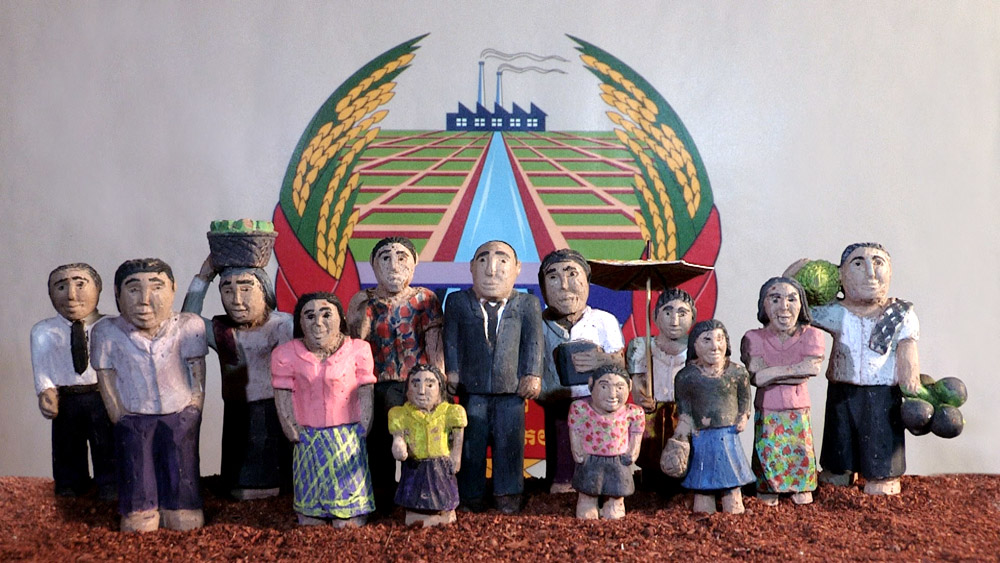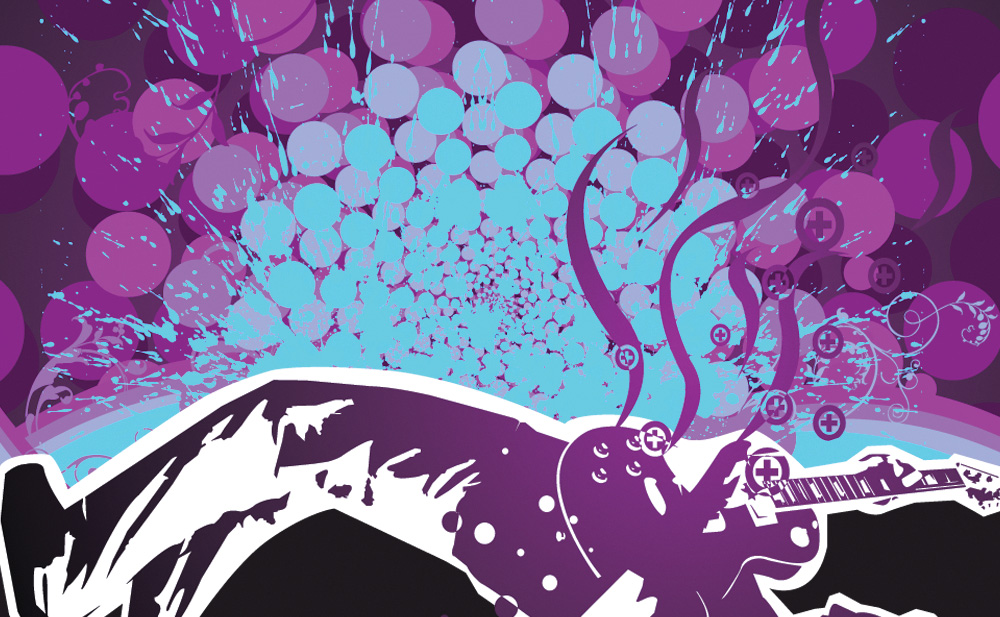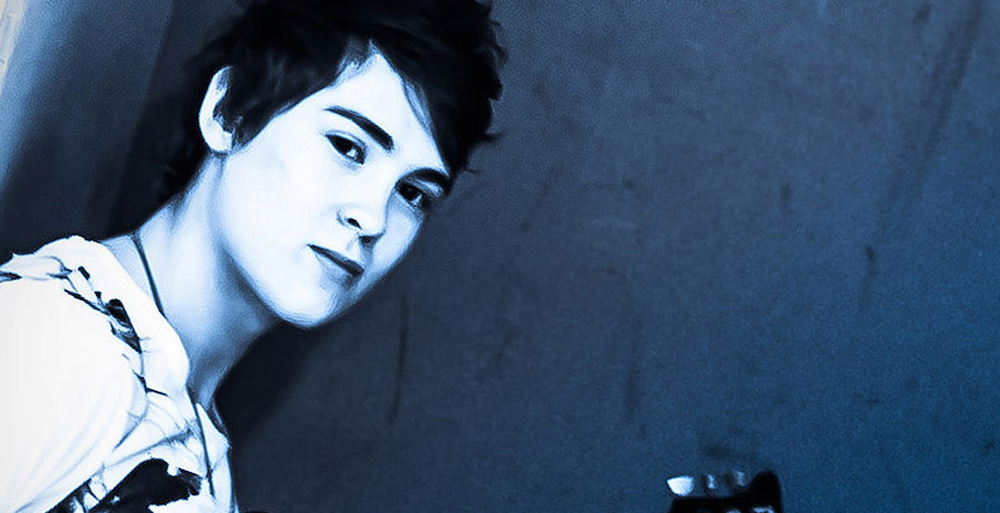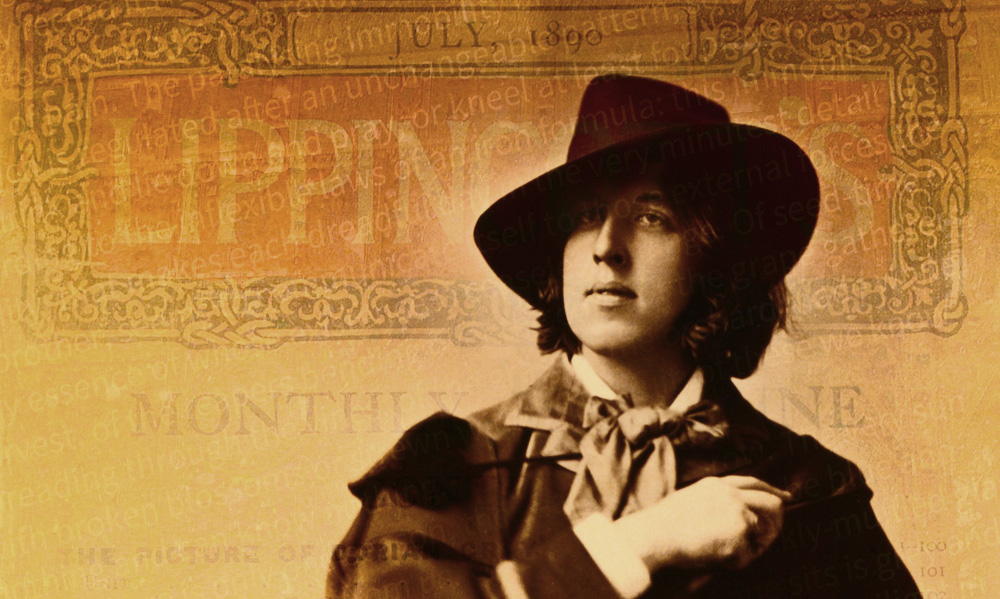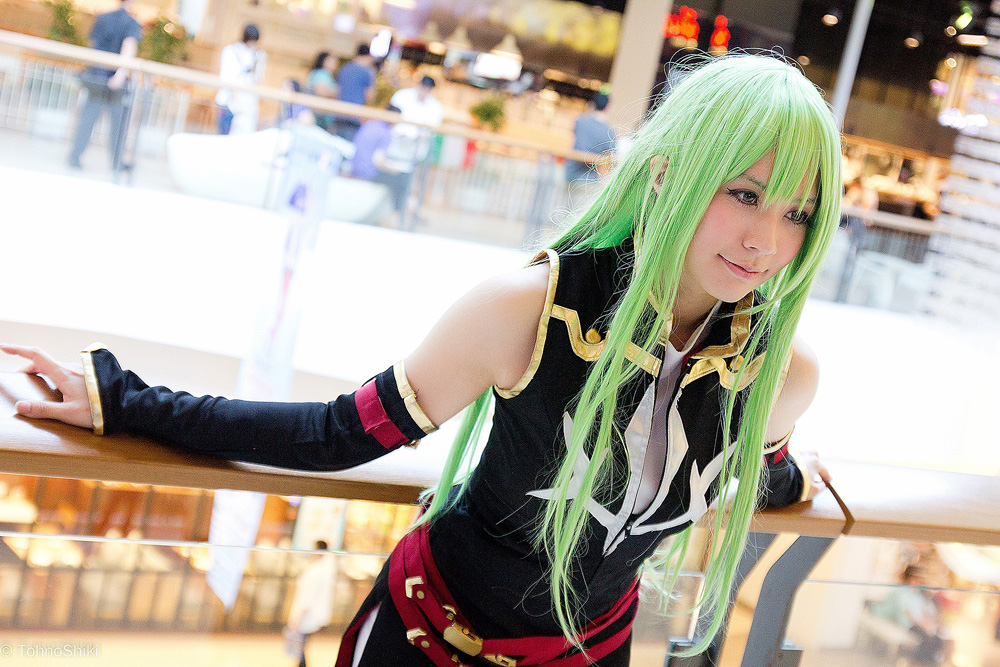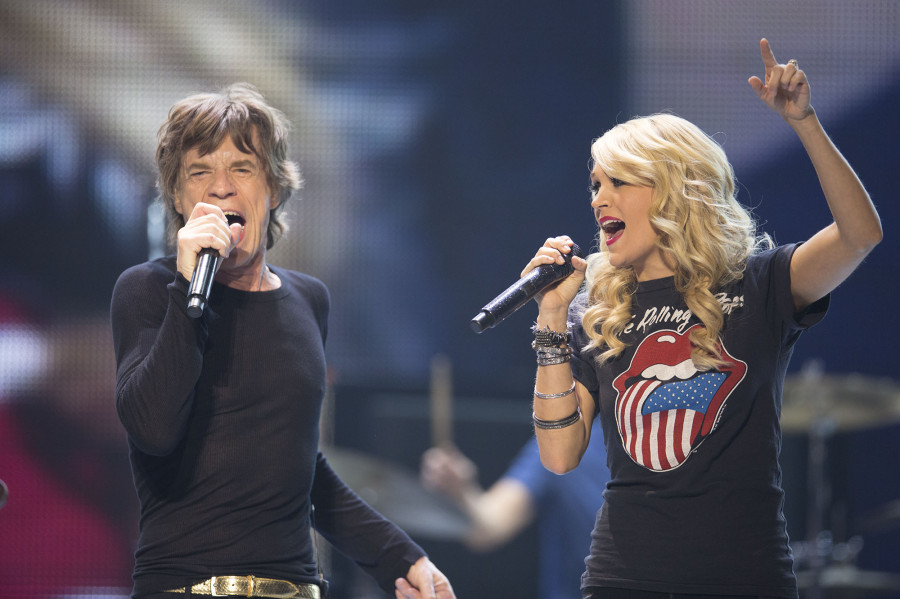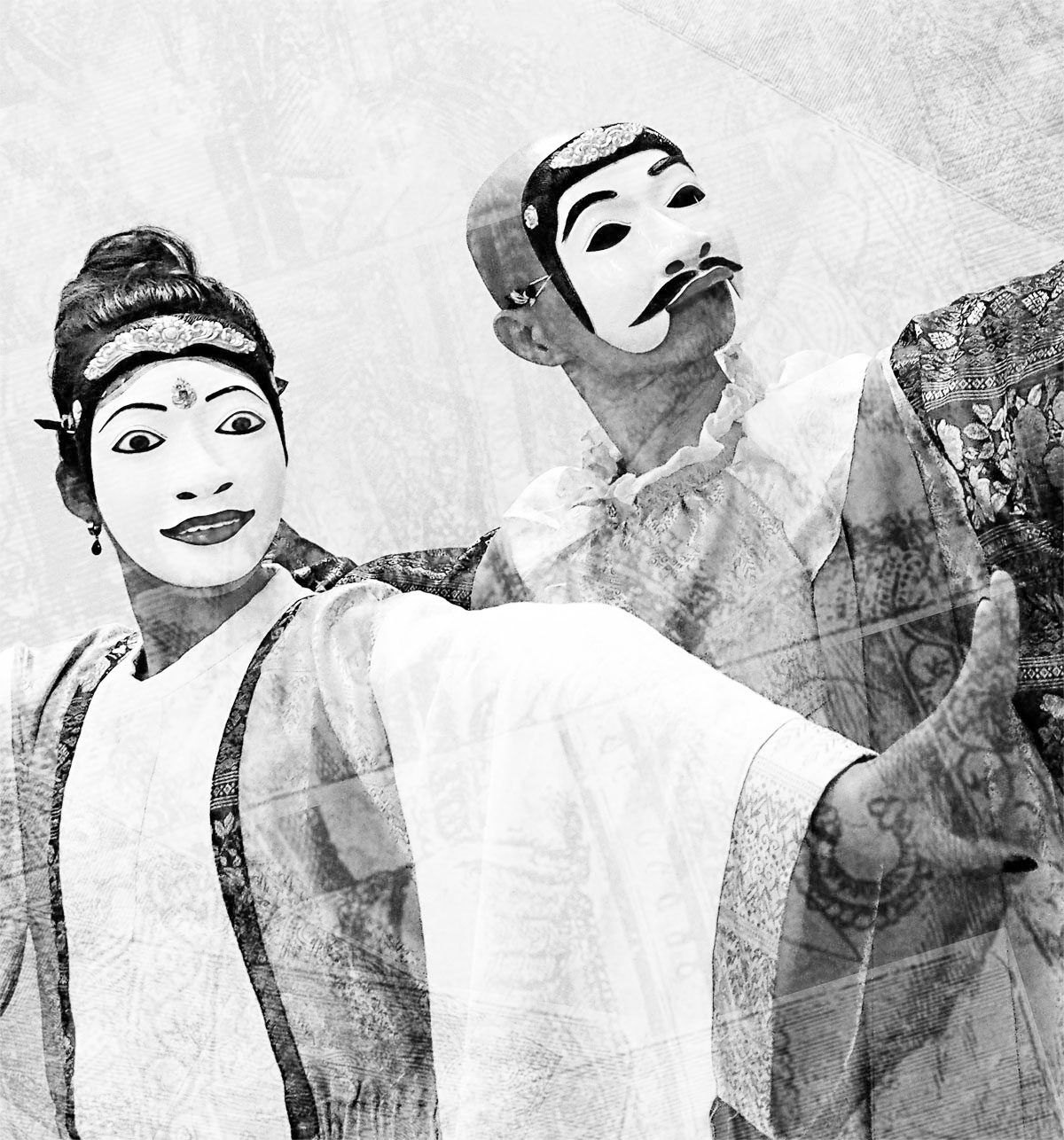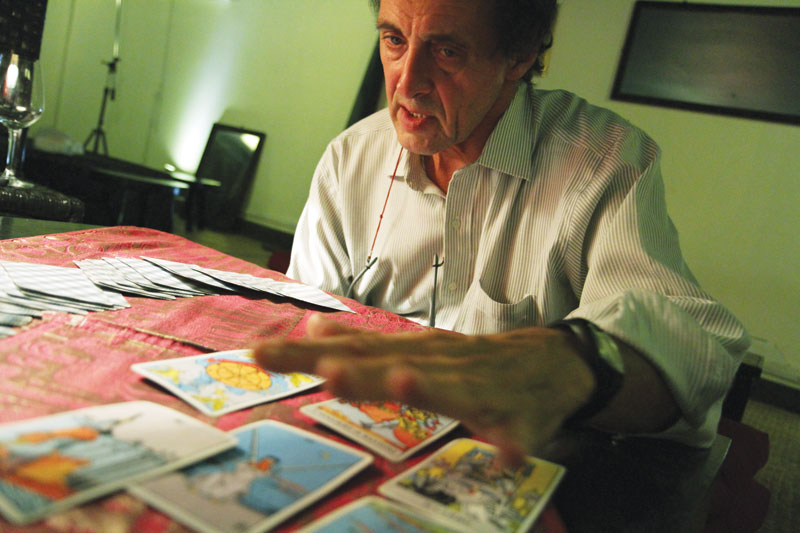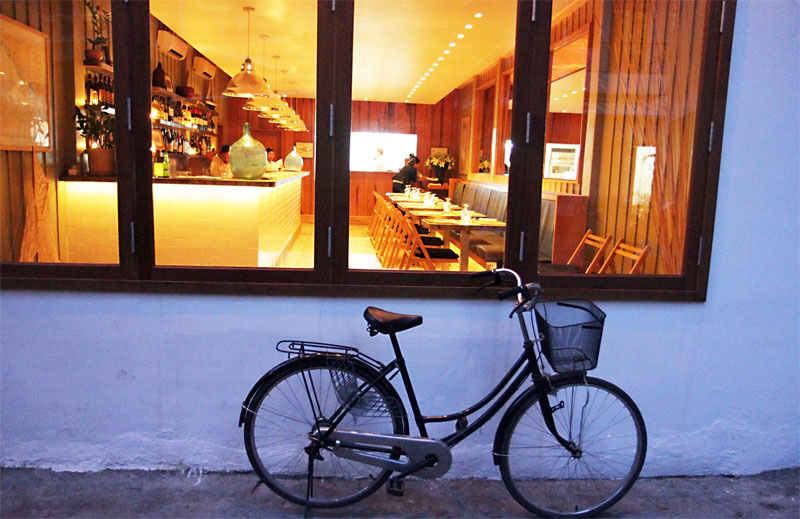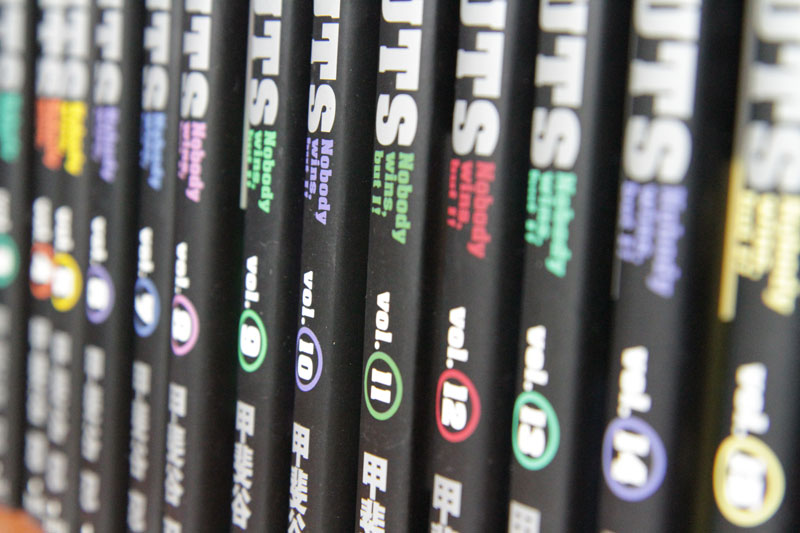When Italians chat, they do so as much with their hands as with their mouths. Gesticulating is a vital part of communication in the country, where roughly 250 gestures are used regularly and studied by scientists and philosophers. When he gestures, diminutive Italian pianist Gabri Faja, whose sheer force of presence dwarves his physical size, does so nimbly, posing questions with open palms.
In a 4am flash of inspiration, this Italian scholar of the UK’s Royal College of Music (who also directs The Piano Shop; Soundskool Music Solutions and is the new events manager at Doors) says by email: “Phnom Penh is a volcano powered by creative magma – everything is possible, all dreams can come true – and it hasn’t even started smoking yet. You simply cannot organise a festival in two weeks and get away with it. Really, this is ridiculous and it can only happen here. The wealth of talent is astounding for a city this size, from writers to poets, jammers to drummers, painters to sprayers and other species in between. I. LOVE. IT.”
As well he should. Some 50-plus of the capital’s finest musicians are assembling because of him for Vibe, a ten-day music festival this month that will feature upwards of 17 bands – and a 3D mapper, fellow Italian VJ/DJ Roberto, whose dreadlocks must weigh almost as much as the man himself. “Basically, I put you on a blackout wall there and shoot onto you only and I can change your face; I can make your hair blonde; it’s unreal!” says Gabi. “I can make you walk out of yourself! Not me, but Roberto does this. He’s a mega, mega guy.”
Fittingly, the festival is carved up into three ‘vibes’: Dancing & Bouncing (August 16, 17, 18 & 23), Cooling & Chilling (18, 19, 20, 21, 22 & 25) and Quiet Listening (24), the only night for which there’s a cover charge ($3, available in advance at Doors on Street 84 & 47 and The Piano Shop on Street 13 & 178). The central message, says Gabi, is one of friendship.
“Phnom Penh is a village and it always will be, with people checking in and passing by; new-found friends leaving for good and waving goodbye. It is a mixture of emotions held together by this strange, gravitational anomaly that propels me forward; it’s like being on the moon, bouncing around and waiving my arms like a little kid. The never-ending conversations about what to play, where to eat, who to shag, what to write and where shall we meet? And if this is all too much, home alone does it just fine, knowing that outside it’s there for me, five minutes away.”
VIBE: THE HIGHLIGHTS
9pm August 16: Dub Addiction & Roberto
“Arguably Cambodia’s tightest and most professional band in their last gig before their European tour, with new faces and tunes. Roberto provides snippets of latest-technology 3D video-mapping and visuals” – Gabi Faja
Dub Addiction features a veritable Who’s Who of the local reggae scene, but the main ragamuffin toasters are MC Curly and DJ Khla, the latter someone German music producer Professor Kinski compares to Cutty Ranks, Sizla and Anthony B. Sights and sounds familiar to Phnom Penh long-termers ooze through the mixer to create a distinctly Cambodian soundscape. A high point – if you’ll pardon the pun – is The Mighty Plan, on which “the voice of LSD guru Terence McKenna is lecturing about mankind’s first contact with aliens over an ultra-massive slow shuffle dub groove of Lee Perry”. “We intend to conquer the universe,” a disembodied voice declares as one track drives its mega-phat electro dub juggernaut into your sternum. Accompanying the wobble bass and distorted e-guitar solos will be a 3D visual feast by VJ/DJ Roberto. Psychedelics not essential.
9pm August 17: Vibratone & Bluesabelle
“Making a big splash in their second time out, this much-needed addition to the upbeat reggae scene is a great new band featuring the insanely talented Luis ‘El Brazilero’ and will be followed by just about the best jazz DJ in Asia” – Gabi Faja
Named in honour of Fender’s Leslie speaker, designed for use with electric guitars, Vibratone are a new all-original reggae band. Following them is Lady Bluesabelle, originally from Australia and now resident at Sofitel. She’s been host DJ for the Brooklyn International Film Festival; crowned the Philippines’ Nova Lounge Queen on Asia MTV; played fine jazz for the launch of Ministry of Sound Radio’s chill-out sessions in London and was the first female DJ in Goa, India. Along the way, she’s worked alongside everyone from Al Green to Herbie Hankock. Expect a selection from Caribbean and funk to electro swing and Afro beat.
7:30pm August 18: Kin & Swing Kings
“The capital’s awesome jazz band returns after three months for a night of bop and swing dancing and original arrangements, featuring a grand piano and Euan Gray on tenor sax” – Gabi Faja
What happens when three of the capital’s jazz pioneers adopt their very own saxophonist? Kin – not just by name, but by nature. Gabi Faja (piano), Sebastien Adnot (double bass) and Toma Willen (drums), known in their own right as the GTS Jazz Trio, recently joined creative forces with Euan Gray, front man of Australia’s The Rooftops and now a permanent Phnom Penh resident. New forays include pop, rhythm and soul, but all bundled into a jazz aficionado-friendly package. Expect “funky stuff,” Sebastien, one of two Frenchmen in the band along with Toma, says, like Stevie Wonder. “We are all from very different backgrounds,” says Gabi. “Classical, gypsy, jazz, reggae. In fact, our music is a hybrid of all.” Fitting accompaniment to it all are fleet-footed lindyhoppers the Swing Kings.
7:30pm August 19: Cambostomp
“An awesome Cambodian drum show by scary good, grooving local artists” – Gabi Faja
For centuries, the sound of the skor (‘drum’) has been at the very core of Cambodia’s musical traditions, seen as a way of emulating the sound of thunder; an important way of connecting to the natural world. In the instrument’s absence, Cambodians will convert almost anything to create the necessary rhythms, from striking pots and plates with cutlery to banging on the bottom of an upturned stool. The country boasts more than 10 main types of drum, most made of wood – often the jackfruit tree – and covered with animal skin. Historically, their purposes have been many, from ‘female’ and ‘male’ drums representing the bride and groom at a wedding, to the skor chey (‘soldier drum’) used to transmit military information in secret. Tonight, rousing traditional beats from the Pin Peat Orchestra at Sovanna Phum lend a distinctly tribal feel to the evening, from the percussive rumana to the giant, barrel-shaped skor thom.
8pm August 20: Wash
“The man responsible for riveting acts of original music-making in town lets out his acoustic-based read-out-loud originals in this musical poetry project” – Gabi Faja
Fronted by Scott ‘kind of a music guy; writes a bit’ Bywater, Wash brings together some of the city’s most inventive souls. There’s DJ/VJ Warren Daly; electronic musician Alex Leonard, one of the original Grass Snake Union line-up, and ‘English production guy’ Hal FX whose recent performance at Le Jardin was his first public gig in years. Here, exotic soundscapes meet stunning visuals and dreamy spoken word in a collaborative effort that stimulates several senses at once. “We’re working on brand new pieces, which we are increasingly excited about,” says Scott. “The text is poems that I’ve been writing this year and we’re now more confident about what it is we’re putting together. The music is a bit more written this time. It’s like having learned how to drive the vehicle, we’ve thrown away the manual and now we’re converting it into something amphibious.” Listen out for beats, loops, bass lines and sound effects courtesy of two laptops plus a midi guitar and a midi keyboard fed through a laptop. Cripes.
8:30pm August 21: Joe Wrigley and the Jumping Jacks
“The only thing that was missing in town was Mr Wrigley. Now completing the Penh’s surreal music scene, Joe and friends bring you an evening of awesome songs from the West Side” – Gabi Faja
British-born country singer/songwriter Joe Wrigley meets the Cambodian Space Project’s Scott Bywater (vocals) and Adrien (bass) in what was originally intended to be a Buddy Holly tribute band but has since evolved into a “vampire rockabilly” trio. “We’re going for the Sun Records/Gene Vincent kind of sound,” says Joe. “We’re all into our ’50s stuff, so it will be authentic in terms of the rockabilly spirit and there will be originals in the set list too, with some Khmer vocals from Melea. It’s the awesome era of guitar sound in between jazz and rock music, so players like Cliff Gallup and Scotty Moore were playing big archtops and gretsches very loud with lots of echo and it sounds like they’re just making up rock ‘n’ roll on the spot. You have that energy combined with the wild exuberance of early Elvis and Gene Vincent and it’s just wild, wild. It’s experimental and primitive and rough and sounds like it was written and recorded in two takes: that’s the energy that I want to happen onstage. I have a jacket being worked on at the tailors. Just wish I still had my quiff!”
7pm August 22: Khemera, Akhia & Amanda Bloom
“Sam’s rebellious-yet-understated pop vocals from Khemera; 15-year-old sensation Akhia and the beautiful, seductive and all-original voice of Miss Bloom all make for an evening never offered before. Watch out for a guitar, a grand piano, a spotlight and a mic, because that’s all they need” – Gabi Faja
Doubling as frontwoman for post-hardcore band No Forever, 22-year-old Sam tonight goes unplugged, along with her guitarist Tim, in acoustic act Khemera. And it’s all about love, apparently. “The name Khemera means we are Khmer youth and Khmer people,” she says of the 14-month-old pop, rock and, well, pop-rock duo. “We love making music. We want to show that Khmer young people have the ability to do so. We can do it. We love it and we do what we can and what we love. We love to bring people together with the music and joy.” Watch out also for Akhia, a self-taught guitarist from the Philippines who will be channelling Chrissy Constanza, Alex Goot and Boyce Avenue. Amanda Bloom, meanwhile, arrives fresh from recording her second album, Atlas, which features Australian saxophonist Euan Gray and Malaysian Asia Beat drummer Lewis Pragasam. “The album draws its inspiration from my experiences living in Cambodia for the last two years and is a melting pot of world, classical and piano-driven melodic pop music,” says Amanda. She is perhaps best known for a song by the name of Rosetta, from her first album – so called in honour of the Rosetta Stone, which famously unlocked the secrets of Ancient Egypt. The track contains the line: ‘An idea does not gain truth as it gains followers’ which, when the album was released in 2010, was immediately seized upon by freethinkers the world over. They’ve since been immortalised on everything from websites and radio shows to t-shirts and at least one tattoo.
9pm August 23: Jahzad & Lady Bluesabelle
“Sebastian Adnot’s latest mega-successful band, ska sensation Jahzad kill you with their unstoppable bouncing groove. Party time is here! DJ set by Bluesabelle to chill your spirits while keeping you going” – Gabi Faja
Mixing the danceable rhythms of The Skatalites with popular jazz are some of Phnom Penh’s most talented musicians, among them Sebastien Adnot (bass), Greg Lavender (drums) and Alexandre Scarpati (trombone). Afterwards, expect from Lady Bluesabelle everything from Caribbean and funk to electro swing and Afro beat.
7:30pm August 24: Master Kong Nay & Krom & VJ Roberto
“Possibly the most important musician from the Kingdom, Master Kong Nay is one of the world’s finest chapei players. He has played in packed halls from Asia to New York and tonight makes an extremely rare live appearance. He will be followed by the magical beauty of Krom, who deliver moving, sensual vocals with understated acoustic accompaniment. In combination with VJ Roberto on projectors, this evening provides a theatre for the meaningful and silent listener” – Gabi Faja
Silence is indeed the only way to greet certain works by Krom. She’s 7 Years Old (Her Body Sold), from the band’s forthcoming second album, Krom – Neon Dark, is perhaps the single most disturbing item on the Vibe menu. It recounts the true story of a Cambodian child sold into sexual slavery, and was described by BBC broadcaster Mark Coles as “Harrowing; a very disturbing, powerful song.” Songwriter Christopher Minko wrote the lyrics after reading a news report in the local press that described the rescue of a girl from sex traders on the Thai-Cambodia border. The photo showed her chained to a bed, “a horrendous mix of fear and utter bewilderment shown within the eyes of the enslaved young girl”, says Minko, noting that the song “is meant to make the listener feel uncomfortable, very uncomfortable”. On an ever-so-slightly lighter note, Krom will also perform material from their first album, Songs From The Noir, featuring the ethereal vocals of sisters Sopheak and Sophea Chamroeun, for which the band is famed. Even more famous is master musician Kong Nay, one of the few to survive the Khmer Rouge and known respectfully as ‘the Ray Charles of Cambodia’.
8pm August 25: Charlie Corrie, Euan Gray & Friends
“The festival finale involves the finest songwriters and solo acts in town, a fitting end bringing all of our friends together. Euan Gray goes all-original for the first time, after which a jam session is highly likely” – Gabi Faja
Drawing on the sounds of Smokey Robinson and Sam Cook, with just a dash of James Morrison and Gavin Degraw, self-taught pianist/guitarist Charlie Corrie will perform a selection of covers and his own work. “I’m writing new songs now which I hope to turn into an EP,” he says (proceeds will go to help Cambodian singer/songwriters record their own original music through Euan Gray’s Songkites project at Ragamuffin House. Euan, frontman of Brisbane-based band The Rooftops, has promised his first all-original solo in Phnom Penh: “It will be some Rooftops stuff, some non-Rooftops stuff and possibly some new stuff. This could be my long-awaited push to finish some new songs I’ve been dreaming up. I have half a chorus for a new song, called Paper Lexus. Last Chinese New Year, I saw people burning paper, factory made Lexuses along with fake money. All things will pass. Amazing symbolism: ironic and hopeful at the same time. I have another one that no one has heard yet called We Live Amongst The Tigers, about how ex-Khmer Rouge are everyday folk, driving our tuk tuks, planting rice, doing business; all trying to move on. ‘Working hard at moving on, working just as hard as anyone…’”
VIBE: THE HIGHLIGHTS
9pm August 16: Dub Addiction & Roberto
“Arguably Cambodia’s tightest and most professional band in their last gig before their European tour, with new faces and tunes. Roberto provides snippets of latest-technology 3D video-mapping and visuals” – Gabi Faja
Dub Addiction features a veritable Who’s Who of the local reggae scene, but the main ragamuffin toasters are MC Curly and DJ Khla, the latter someone German music producer Professor Kinski compares to Cutty Ranks, Sizla and Anthony B. Sights and sounds familiar to Phnom Penh long-termers ooze through the mixer to create a distinctly Cambodian soundscape. A high point – if you’ll pardon the pun – is The Mighty Plan, on which “the voice of LSD guru Terence McKenna is lecturing about mankind’s first contact with aliens over an ultra-massive slow shuffle dub groove of Lee Perry”. “We intend to conquer the universe,” a disembodied voice declares as one track drives its mega-phat electro dub juggernaut into your sternum. Accompanying the wobble bass and distorted e-guitar solos will be a 3D visual feast by VJ/DJ Roberto. Psychedelics not essential.
9pm August 17: Vibratone & Bluesabelle
“Making a big splash in their second time out, this much-needed addition to the upbeat reggae scene is a great new band featuring the insanely talented Luis ‘El Brazilero’ and will be followed by just about the best jazz DJ in Asia” – Gabi Faja
Named in honour of Fender’s Leslie speaker, designed for use with electric guitars, Vibratone are a new all-original reggae band. Following them is Lady Bluesabelle, originally from Australia and now resident at Sofitel. She’s been host DJ for the Brooklyn International Film Festival; crowned the Philippines’ Nova Lounge Queen on Asia MTV; played fine jazz for the launch of Ministry of Sound Radio’s chill-out sessions in London and was the first female DJ in Goa, India. Along the way, she’s worked alongside everyone from Al Green to Herbie Hankock. Expect a selection from Caribbean and funk to electro swing and Afro beat.
7:30pm August 18: Kin & Swing Kings
“The capital’s awesome jazz band returns after three months for a night of bop and swing dancing and original arrangements, featuring a grand piano and Euan Gray on tenor sax” – Gabi Faja
What happens when three of the capital’s jazz pioneers adopt their very own saxophonist? Kin – not just by name, but by nature. Gabi Faja (piano), Sebastien Adnot (double bass) and Toma Willen (drums), known in their own right as the GTS Jazz Trio, recently joined creative forces with Euan Gray, front man of Australia’s The Rooftops and now a permanent Phnom Penh resident. New forays include pop, rhythm and soul, but all bundled into a jazz aficionado-friendly package. Expect “funky stuff,” Sebastien, one of two Frenchmen in the band along with Toma, says, like Stevie Wonder. “We are all from very different backgrounds,” says Gabi. “Classical, gypsy, jazz, reggae. In fact, our music is a hybrid of all.” Fitting accompaniment to it all are fleet-footed lindyhoppers the Swing Kings.
7:30pm August 19: Cambostomp
“An awesome Cambodian drum show by scary good, grooving local artists” – Gabi Faja
For centuries, the sound of the skor (‘drum’) has been at the very core of Cambodia’s musical traditions, seen as a way of emulating the sound of thunder; an important way of connecting to the natural world. In the instrument’s absence, Cambodians will convert almost anything to create the necessary rhythms, from striking pots and plates with cutlery to banging on the bottom of an upturned stool. The country boasts more than 10 main types of drum, most made of wood – often the jackfruit tree – and covered with animal skin. Historically, their purposes have been many, from ‘female’ and ‘male’ drums representing the bride and groom at a wedding, to the skor chey (‘soldier drum’) used to transmit military information in secret. Tonight, rousing traditional beats from the Pin Peat Orchestra at Sovanna Phum lend a distinctly tribal feel to the evening, from the percussive rumana to the giant, barrel-shaped skor thom.
8pm August 20: Wash
“The man responsible for riveting acts of original music-making in town lets out his acoustic-based read-out-loud originals in this musical poetry project” – Gabi Faja
Fronted by Scott ‘kind of a music guy; writes a bit’ Bywater, Wash brings together some of the city’s most inventive souls. There’s DJ/VJ Warren Daly; electronic musician Alex Leonard, one of the original Grass Snake Union line-up, and ‘English production guy’ Hal FX whose recent performance at Le Jardin was his first public gig in years. Here, exotic soundscapes meet stunning visuals and dreamy spoken word in a collaborative effort that stimulates several senses at once. “We’re working on brand new pieces, which we are increasingly excited about,” says Scott. “The text is poems that I’ve been writing this year and we’re now more confident about what it is we’re putting together. The music is a bit more written this time. It’s like having learned how to drive the vehicle, we’ve thrown away the manual and now we’re converting it into something amphibious.” Listen out for beats, loops, bass lines and sound effects courtesy of two laptops plus a midi guitar and a midi keyboard fed through a laptop. Cripes.
8:30pm August 21: Joe Wrigley and the Jumping Jacks
“The only thing that was missing in town was Mr Wrigley. Now completing the Penh’s surreal music scene, Joe and friends bring you an evening of awesome songs from the West Side” – Gabi Faja
British-born country singer/songwriter Joe Wrigley meets the Cambodian Space Project’s Scott Bywater (vocals) and Adrien (bass) in what was originally intended to be a Buddy Holly tribute band but has since evolved into a “vampire rockabilly” trio. “We’re going for the Sun Records/Gene Vincent kind of sound,” says Joe. “We’re all into our ’50s stuff, so it will be authentic in terms of the rockabilly spirit and there will be originals in the set list too, with some Khmer vocals from Melea. It’s the awesome era of guitar sound in between jazz and rock music, so players like Cliff Gallup and Scotty Moore were playing big archtops and gretsches very loud with lots of echo and it sounds like they’re just making up rock ‘n’ roll on the spot. You have that energy combined with the wild exuberance of early Elvis and Gene Vincent and it’s just wild, wild. It’s experimental and primitive and rough and sounds like it was written and recorded in two takes: that’s the energy that I want to happen onstage. I have a jacket being worked on at the tailors. Just wish I still had my quiff!”
7pm August 22: Khemera, Akhia & Amanda Bloom
“Sam’s rebellious-yet-understated pop vocals from Khemera; 15-year-old sensation Akhia and the beautiful, seductive and all-original voice of Miss Bloom all make for an evening never offered before. Watch out for a guitar, a grand piano, a spotlight and a mic, because that’s all they need” – Gabi Faja
Doubling as frontwoman for post-hardcore band No Forever, 22-year-old Sam tonight goes unplugged, along with her guitarist Tim, in acoustic act Khemera. And it’s all about love, apparently. “The name Khemera means we are Khmer youth and Khmer people,” she says of the 14-month-old pop, rock and, well, pop-rock duo. “We love making music. We want to show that Khmer young people have the ability to do so. We can do it. We love it and we do what we can and what we love. We love to bring people together with the music and joy.” Watch out also for Akhia, a self-taught guitarist from the Philippines who will be channelling Chrissy Constanza, Alex Goot and Boyce Avenue. Amanda Bloom, meanwhile, arrives fresh from recording her second album, Atlas, which features Australian saxophonist Euan Gray and Malaysian Asia Beat drummer Lewis Pragasam. “The album draws its inspiration from my experiences living in Cambodia for the last two years and is a melting pot of world, classical and piano-driven melodic pop music,” says Amanda. She is perhaps best known for a song by the name of Rosetta, from her first album – so called in honour of the Rosetta Stone, which famously unlocked the secrets of Ancient Egypt. The track contains the line: ‘An idea does not gain truth as it gains followers’ which, when the album was released in 2010, was immediately seized upon by freethinkers the world over. They’ve since been immortalised on everything from websites and radio shows to t-shirts and at least one tattoo.
9pm August 23: Jahzad & Lady Bluesabelle
“Sebastian Adnot’s latest mega-successful band, ska sensation Jahzad kill you with their unstoppable bouncing groove. Party time is here! DJ set by Bluesabelle to chill your spirits while keeping you going” – Gabi Faja
Mixing the danceable rhythms of The Skatalites with popular jazz are some of Phnom Penh’s most talented musicians, among them Sebastien Adnot (bass), Greg Lavender (drums) and Alexandre Scarpati (trombone). Afterwards, expect from Lady Bluesabelle everything from Caribbean and funk to electro swing and Afro beat.
7:30pm August 24: Master Kong Nay & Krom & VJ Roberto
“Possibly the most important musician from the Kingdom, Master Kong Nay is one of the world’s finest chapei players. He has played in packed halls from Asia to New York and tonight makes an extremely rare live appearance. He will be followed by the magical beauty of Krom, who deliver moving, sensual vocals with understated acoustic accompaniment. In combination with VJ Roberto on projectors, this evening provides a theatre for the meaningful and silent listener” – Gabi Faja
Silence is indeed the only way to greet certain works by Krom. She’s 7 Years Old (Her Body Sold), from the band’s forthcoming second album, Krom – Neon Dark, is perhaps the single most disturbing item on the Vibe menu. It recounts the true story of a Cambodian child sold into sexual slavery, and was described by BBC broadcaster Mark Coles as “Harrowing; a very disturbing, powerful song.” Songwriter Christopher Minko wrote the lyrics after reading a news report in the local press that described the rescue of a girl from sex traders on the Thai-Cambodia border. The photo showed her chained to a bed, “a horrendous mix of fear and utter bewilderment shown within the eyes of the enslaved young girl”, says Minko, noting that the song “is meant to make the listener feel uncomfortable, very uncomfortable”. On an ever-so-slightly lighter note, Krom will also perform material from their first album, Songs From The Noir, featuring the ethereal vocals of sisters Sopheak and Sophea Chamroeun, for which the band is famed. Even more famous is master musician Kong Nay, one of the few to survive the Khmer Rouge and known respectfully as ‘the Ray Charles of Cambodia’.
8pm August 25: Charlie Corrie, Euan Gray & Friends
“The festival finale involves the finest songwriters and solo acts in town, a fitting end bringing all of our friends together. Euan Gray goes all-original for the first time, after which a jam session is highly likely” – Gabi Faja
Drawing on the sounds of Smokey Robinson and Sam Cook, with just a dash of James Morrison and Gavin Degraw, self-taught pianist/guitarist Charlie Corrie will perform a selection of covers and his own work. “I’m writing new songs now which I hope to turn into an EP,” he says (proceeds will go to help Cambodian singer/songwriters record their own original music through Euan Gray’s Songkites project at Ragamuffin House. Euan, frontman of Brisbane-based band The Rooftops, has promised his first all-original solo in Phnom Penh: “It will be some Rooftops stuff, some non-Rooftops stuff and possibly some new stuff. This could be my long-awaited push to finish some new songs I’ve been dreaming up. I have half a chorus for a new song, called Paper Lexus. Last Chinese New Year, I saw people burning paper, factory made Lexuses along with fake money. All things will pass. Amazing symbolism: ironic and hopeful at the same time. I have another one that no one has heard yet called We Live Amongst The Tigers, about how ex-Khmer Rouge are everyday folk, driving our tuk tuks, planting rice, doing business; all trying to move on. ‘Working hard at moving on, working just as hard as anyone…’”
